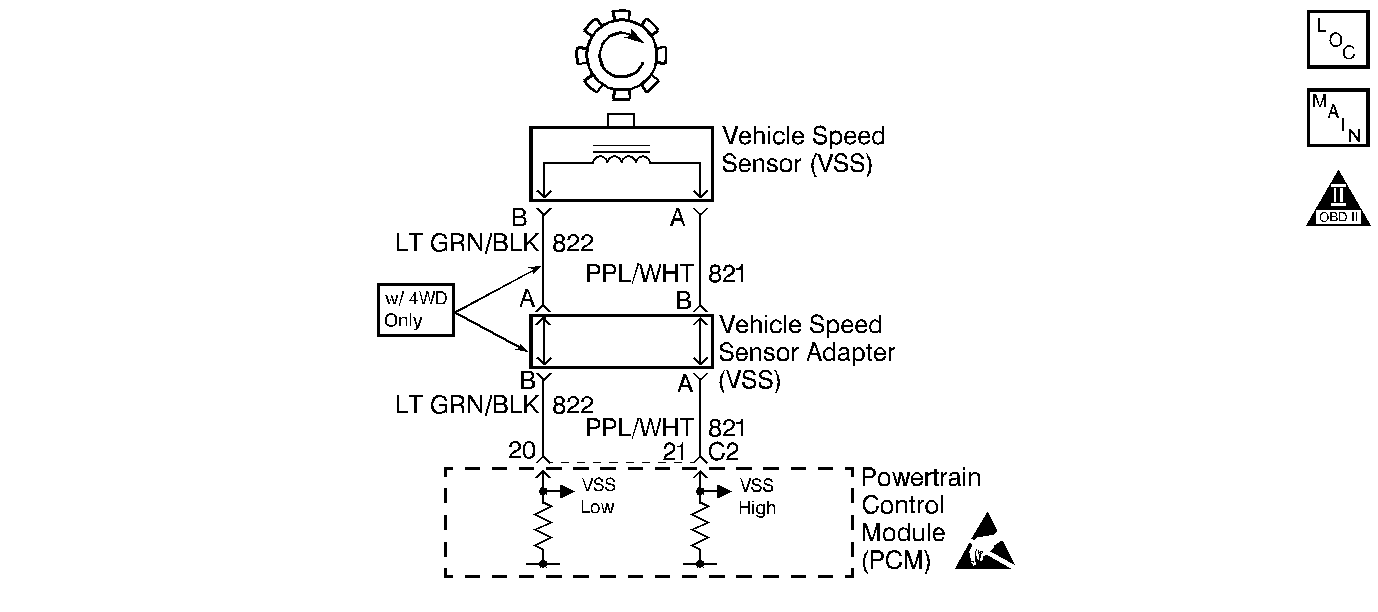
Circuit Description
A toothed wheel mounted on the output shaft of the transmission generates an AC voltage pulse as it moves past the Vehicle Speed Sensor (VSS). The VSS contains a permanent magnet surrounded by a coil of wire, which produces a magnetic field. The toothed wheel interrupts the magnetic field that generates an AC voltage pulse. As the vehicle speed increases the AC voltage pulse rate also increases.
Conditions for Running the DTC
| • | DTCs P0107, P0108, P0117, P0118, P0121, P0122, P0123, P0125, P0506, P0507 are not set. |
| • | The engine coolant temperature is greater than 35°C (95°F). |
| • | The engine speed is greater than 1000 RPM. |
| • | The TP sensor angle is between 5.0% and 100%. |
| • | The MAP is between 40 kPa and 100 kPa when the A/C is OFF. |
| • | The MAP is between 45 kPa and 100 kPa when the A/C is ON. |
| • | All conditions met for 2.0 seconds. |
Conditions for Setting the DTC
The PCM detects vehicle speed at 0 km/h (0 mph) for 100 seconds.
Action Taken When the DTC Sets
| • | The PCM illuminates the malfunction indicator lamp (MIL) on the second consecutive ignition cycle that the diagnostic runs and fails. |
| • | The PCM records the operating conditions at the time the diagnostic fails. The first time the diagnostic fails, the PCM stores this information in the Failure Records. If the diagnostic reports a failure on the second consecutive ignition cycle, the PCM records the operating conditions at the time of the failure. The PCM writes the conditions to the Freeze Frame and updates the Failure Records. |
Conditions for Clearing the MIL/DTC
| • | The PCM turns OFF the malfunction indicator lamp (MIL) after 3 consecutive ignition cycles that the diagnostic runs and does not fail. |
| • | A last test failed, or current DTC, clears when the diagnostic runs and does not fail. |
| • | A history DTC clears after 40 consecutive warm-up cycles, if no failures are reported by this or any other emission related diagnostic. |
| • | Use a scan tool in order to clear the MIL and the DTC. |
Diagnostic Aids
Important:
• This diagnostic is for manual transmission vehicles only. • Remove any debris from the PCM connector surfaces before servicing
the PCM. Inspect the PCM connector gaskets when diagnosing/replacing
the PCM. Ensure that the gaskets are installed correctly. The gaskets
prevent water intrusion into the PCM.
Inspect all of the circuits to the PCM and the VSS. Inspect the terminal connections at the VSS harness connector and at the PCM harness connector. If the vehicle is equipped with four wheel drive inspect the circuits/connections at the jumper harness. If all of the circuits and connections are OK, replace the PCM.
For an intermittent, refer to Symptoms .
Test Description
The numbers below refer to the step numbers on the diagnostic table.
Step | Action | Value(s) | Yes | No |
|---|---|---|---|---|
1 | Did you perform the Powertrain On-Board Diagnostic (OBD) System Check? | -- | ||
Does the scan tool indicate a vehicle speed above the specified value? | 24 kph (15 mph) | Go to Diagnostic Aids | ||
3 |
Slowly bring the engine speed to 1500 RPM and hold. Does the DMM indicate a voltage above the specified value? | 1.2V | ||
4 |
Is the test lamp illuminated? | -- | ||
5 |
Is the voltage above the specified value? | 0.2V | ||
6 | Test the VSS high circuit for an open or short to ground. Repair if necessary. Refer to Wiring Repairs in Wiring Systems. Did you find and correct the condition? | -- | ||
7 | Repair the short to voltage on the VSS high circuit. Refer to Wiring Repairs in Wiring Systems. Is the action complete? | -- | -- | |
8 | Repair the open/high resistance in the VSS high circuit. Refer to Wiring Repairs in Wiring Systems. Is the action complete? | -- | -- | |
9 |
Important: Inspect the reluctor wheel on the transmission output shaft for damage. Refer to Manual Transmission. Replace the VSS. Refer to Vehicle Speed Sensor in Manual Transmission NV 3500 or Vehicle Speed Sensor in Manual Transmission NV 4500 . Is the action complete? | -- | -- | |
10 | Repair the open in the VSS low circuit. Refer to Wiring Repairs in Wiring Systems. Is the action complete? | -- | -- | |
11 |
Important:: Program the replacement PCM. Refer to Powertrain Control Module Replacement/Programming . Replace the PCM. Is the action complete? | -- | -- | |
12 |
Does the scan tool indicate that this test ran and passed? | -- | ||
13 | Select the Capture Info option and the Review Info option using the scan tool. Does the scan tool display any DTCs that you have not diagnosed? | -- | Go to the applicable DTC table | System OK |
